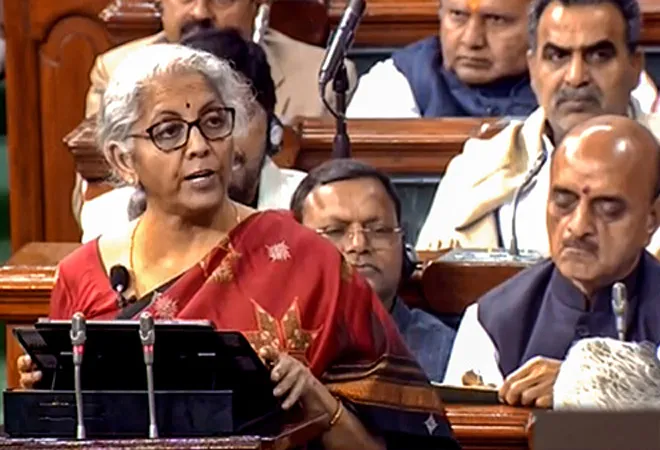-
CENTRES
Progammes & Centres
Location
It is abundantly plain that the salubrity of cities will increasingly determine ‘India’s global profile’

This piece is part of the essay series, Amrit Kaal 1.0: Budget 2023
India’s national budget 2023-24, called the ‘first Budget in Amrit Kaal’ and designed to build on the foundation laid in the previous budget, was presented in Parliament on 1 February 2023. Whereas the budget 2021-22 bestowed a huge thrust to municipal infrastructure through a slew of centrally-sponsored schemes, budget 2022-23 turned its attention principally to municipal reforms in the area of urban planning. In this year’s budget (2023-24), Finance Minister (FM) Nirmala Sitharaman has continued with the domain of municipal reforms and has sought to get them implemented through an incentivisation package for the states and urban local bodies (ULBs).
Many other budgetary provisions not restricted to cities are likely to overflow and enhance city infrastructure, bolster city economy, and catalyse spending by city residents. However, the overall ability of these provisions to enable city governments to augment service delivery levels and embrace vital municipal reforms remains seriously in doubt. This article intends to review some of the provisions that are more urban-centric and assess their likely impact on cities. The more significant intent, however, is to look at the adequacy of the treatment of ULBs. In the context of India’s rising urbanisation, calculated to be standing at 35.9 percent (2022), it is abundantly plain that the salubrity of cities will increasingly determine ‘India’s global profile’.
There are two significant provisions in budget 2022-23 for the urban poor. Towards the very beginning of her presentation, the FM announced the continuation of the PM Garib Kalyan Anna Yojana (PMGKAY), a scheme that was begun in the aftermath of COVID-19 and against the background of enormous distress caused to the poor on account of loss of livelihood opportunities. Slum dwellers in cities and towns faced the brunt of the pandemic and shook the nation by their mammoth journeys back home to survive. The continuation of the scheme for another year will stand the millions of urban poor along with their rural counterparts in good stead as they build their lives back to former shape.
In the context of India’s rising urbanisation, calculated to be standing at 35.9 percent (2022), it is abundantly plain that the salubrity of cities will increasingly determine ‘India’s global profile’.
A further provision, primarily related to the poor, both urban and rural, is for housing. The budget enhanced the outlay for PM Awas Yojana by INR 79,000 crores, a jump of 66 percent over the last outlay. Part of this is expected to go towards affordable housing in urban areas and should improve house ownership of the poor. This is a crying need in urban areas where housing has gone beyond the reach of the poor. However, land availability will pose a serious challenge in many larger cities and government-held lands may have to be offered for the success of the scheme.
The FM was delighted that digital transactions in the country had risen phenomenally and that 7,400 crore digital payments of INR 126 lakh crores were done through UPI in 2022. This marked a 76 percent increase in transactions and 91 percent rise in value over 2021. While news coming in point out that India’s rural areas are increasingly plugging into the digital economy, they are still far behind the cities in UPI usage. We could, therefore, assume that the contribution of urban areas in digitising India’s economy is far greater. Digital payments continue to find wide urban acceptance and the fiscal support assured by the Government of India (GoI) to digital pubic infrastructure in 2023-24 bodes well for the future of the city economy.
In the sphere of health, picking up from the earlier PM Atma Nirbhar Swasth Bharat Yojana, the budget this year proposes the establishment of 157 new nursing colleges to be located around 157 existing medical colleges. Since these are primarily located in district towns, the availability of nurses in these hospitals will mark a qualitative improvement in health services to a whole new set of inadequately served urban areas. A similar focus on tier 2 and 3 cities is reflected in the budget’s recommendation for the revival of fifty smaller airports for improving regional air connectivity. This city-centric infrastructure will boost the economy in medium-sized cities.
While news coming in point out that India’s rural areas are increasingly plugging into the digital economy, they are still far behind the cities in UPI usage.
Budget 2023-24 reflects GoI’s heavy focus on reducing the economy’s carbon intensity and on achieving the energy transition and net zero objectives. Towards this end, green energy, green farming, green mobility, and green buildings – all find encouragement. Scrapping of old polluting vehicles under the vehicle scrapping policy, the construction of 75 compressed biogas (CBG) plants in urban areas under the Gobardhan (Galvanising Organic Bio-Agro Resources Dhan) scheme, a ‘Mangrove Initiative for Shoreline Habitats & Tangible Incomes’ (MISHTI) programme for mangrove plantation along the coastline and on salt pan lands, the promotion of coastal shipping as an energy efficient, low-cost transport alternative in coastal cities, a hundred per cent mechanical desludging of septic tanks and sewers in all cities and enhanced focus for scientific management of dry and wet waste – all these programmes will have a substantial effect on cleaning up cities.
A salutary provision of the budget is the tax exemption to statutory authorities created for housing, planning, development and regulation of human settlements even if such authorities are engaged in some commercial activity. This should encourage these organisations to cross-subsidise poverty schemes and plough back moneys into core activities. The Budget proposes a fifty-year loan to states provided this is totally spent on capital expenditure within 2023-24. The states may choose the area of capital expenditure, but some of the amount would have to be spent, inter alia, on urban planning reforms and financing reforms in ULBs to make them creditworthy for municipal bonds.
Many of the outlays recounted above fall in the category of broad national provisions. It is natural that since India’s economy is getting more and more urban-centric, most budgetary provisions would contribute to city economy and services. However, when we look at paragraphs 53 to 56 of the Budget that are entirely devoted to ULBs, the provisions appear to be predominantly exhortations to the states and cities. The budget assures that states will be encouraged to undertake urban planning reforms and transform cities into ‘sustainable cities of tomorrow’. The question is whether states are prepared to walk that path. Past experience paints a highly negative scenario where almost every GoI attempt has been met with stubborn state negativity. This is true of the Constitution’s 74th Amendment Act, GoI’s model municipal law, JNNURM reforms, model rent control law, and model Nagar Raj Bill.
It is natural that since India’s economy is getting more and more urban-centric, most budgetary provisions would contribute to city economy and services.
The Budget expects states to make efficient use of urban land resources, provide adequate resources for urban infrastructure, direct urban planning towards transit-oriented development, enhance availability and affordability of urban land, and become inclusive in providing opportunities. The Budget pledges to incentivise cities to improve their credit worthiness for municipal bonds through property tax governance reforms and ring-fencing user charges on urban infrastructure. An Urban Infrastructure Development Fund (UIDF) is proposed for use by public agencies to create urban infrastructure in tier 2 and 3 cities. However, this is conditional on the adoption of appropriate user charges by cities, leveraging of resources by states from the grants of the 15th Finance Commission and other existing schemes. A sum of INR. 10,000 crore per annum is proposed for this purpose.
It is true that, constitutionally, urban development is a state subject and GoI would like to work through the states. It is also agreed that, as in the past, GoI would like to give direction towards urban development through the route of financial incentivisation. However, the budget falls seriously short on two counts. First, its incentive package is small and half-hearted. Against the backdrop of enormous sums of money being needed for urban infrastructure (US $840 billion over 15 years as per World Bank estimates), the budget promises modest conditional loans. This is not likely to fly with the states. Second, having stripped the ULBs of their revenue streams by subsuming them into the GST, it is logical to expect that a portion of the GST revenues would be shared by GoI with ULBs. There is no indication that GoI intends to act on this recommendation of the Ministry of Urban Development. From our above cited analysis, it is quite evident that ULBs will continue to remain emaciated and will struggle in the delivery and maintenance of urban services. India’s economic rise is now widely attested. Alas, this does not seem to be converting into robust ULBs delivering their citizens a better quality of life.
The views expressed above belong to the author(s). ORF research and analyses now available on Telegram! Click here to access our curated content — blogs, longforms and interviews.

Dr. Ramanath Jha is Distinguished Fellow at Observer Research Foundation, Mumbai. He works on urbanisation — urban sustainability, urban governance and urban planning. Dr. Jha belongs ...
Read More +